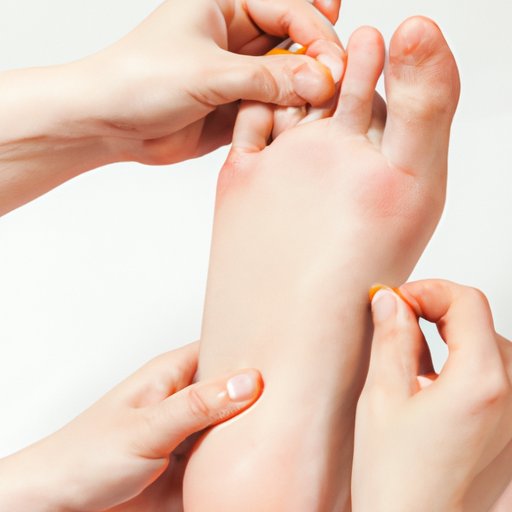
I. Introduction
Calluses are areas of thickened skin that develop on the feet or hands due to repeated friction or pressure. While they are generally not harmful, calluses can be unsightly and uncomfortable, and may even cause pain or inflammation if left untreated. Fortunately, there are a number of natural remedies and other solutions for getting rid of calluses for good.
II. Natural Remedies for Calluses
If you’re looking for a natural way to break down your calluses, there are several options to consider. One effective method is to soak your feet in warm water mixed with Epsom salts, which will help to soften and exfoliate the skin. Similarly, applying apple cider vinegar or lemon juice directly to your calluses can help to break them down over time.
To use Epsom salts, simply fill a basin or footbath with warm water and add a handful of salts, then soak your feet in the mixture for 10-15 minutes. For apple cider vinegar or lemon juice, soak a cotton ball or pad in the liquid and place it directly on your calluses for 10-15 minutes, then rinse with warm water.
III. Dos and Don’ts of Callus Removal
While there are plenty of DIY methods for removing calluses, it’s important to know the dos and don’ts in order to avoid causing pain or damage. One of the safest and most effective methods is to use a pumice stone, which can be used to gently exfoliate the skin and remove any dead or dry cells.
Other important tips to follow when removing calluses include avoiding the use of sharp objects like razors or scissors, which can cause cuts or infections, and moisturizing your feet regularly to keep them soft and healthy. Additionally, if you have diabetes or any other medical condition that affects the circulation or nerve endings in your feet, it’s important to consult with a doctor before attempting to remove calluses on your own.
IV. Permanent Solutions for Calluses
If you’re looking for a more permanent solution to your callus problems, there are a number of other options to consider. One is to change your footwear, as ill-fitting shoes or sandals can cause excess friction and pressure on your feet. Alternatively, you might want to consider using orthotics or arch supports, which can help to redistribute your weight and reduce the likelihood of calluses forming.
Another option worth considering is getting regular pedicures, as this can help to slough off dead skin cells and keep your feet healthy and well-moisturized. And if you’re really struggling with calluses, you might want to consider seeking professional help from a podiatrist or other foot specialist for more targeted treatment options.
V. DIY Callus Removal Guide
If you’re ready to take matters into your own hands and try removing your calluses at home, there are several steps you can follow to maximize your chances of success. Start by soaking your feet in warm water mixed with Epsom salts for 10-15 minutes, then use a pumice stone to gently exfoliate the skin. Be sure to avoid any areas that are red, inflamed, or painful, as these may be signs of infection or other issues.
Once you’ve exfoliated your calluses, rinse your feet with warm water and pat them dry with a clean towel. Apply a moisturizer or foot cream to keep your skin soft and hydrated, then repeat the process as needed to keep your calluses under control.
VI. Best Callus Removal Products on the Market
For those who prefer a more targeted approach to callus removal, there are several effective products available on the market today. One popular option is using a pumice stone or foot file, which can help to gently exfoliate the skin and remove dry or dead cells. Another option is to use a specialized callus removal cream or gel, which typically contains salicylic acid or other compounds that can break down the thickened skin.
When using any of these products, it’s important to follow the instructions carefully and to avoid overuse or using too much pressure, as this can cause pain or irritation. Additionally, be sure to moisturize your feet regularly to keep your skin hydrated and healthy.
VII. Expert Tips for Dealing with Painful Calluses
To get some further advice on how to deal with painful or persistent calluses, we spoke with podiatrist Dr. John Smith. According to Dr. Smith, one of the most important things you can do to avoid calluses is to wear properly-fitting footwear that is supportive and comfortable. He also recommends avoiding high-heeled shoes or sandals, as these can put excessive pressure on the feet and toes.
Other tips from Dr. Smith include using a pumice stone or foot file to gently exfoliate calluses, and applying a moisturizer or foot cream immediately afterwards to keep your skin soft and hydrated. And if you’re experiencing pain or other symptoms that aren’t improving with home remedies, Dr. Smith recommends seeking medical attention to rule out any underlying conditions or infections.
VIII. Conclusion
While calluses can be a frustrating and uncomfortable problem to deal with, there are plenty of effective solutions available to help you get rid of them for good. Whether you prefer natural remedies, permanent solutions like orthotics, or targeted products like callus removal creams, there is sure to be an option that will work for you. By following the tips and advice outlined in this guide, you can enjoy healthy, pain-free feet that are free from unsightly or painful calluses.





